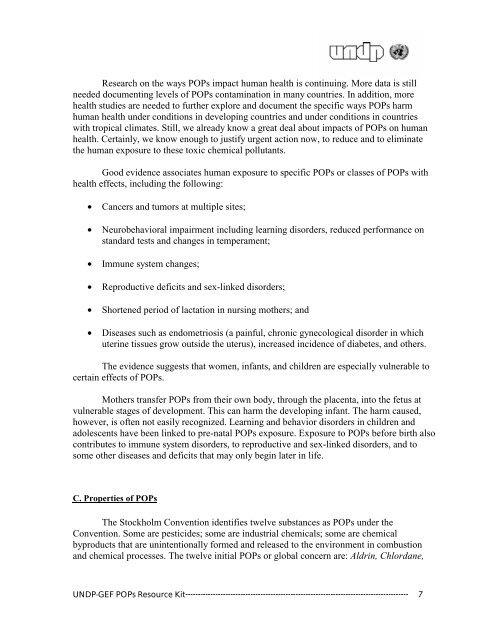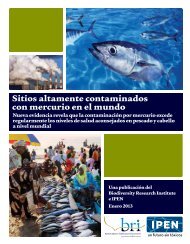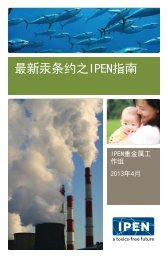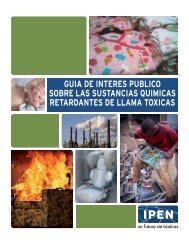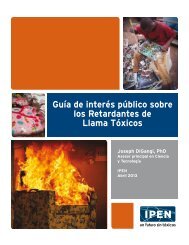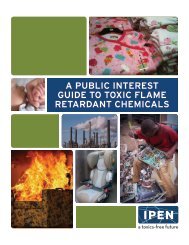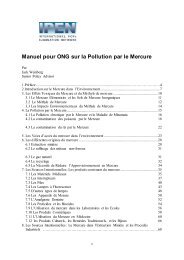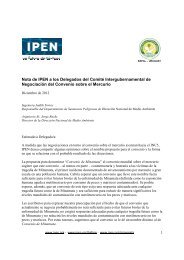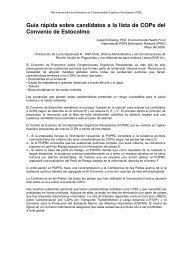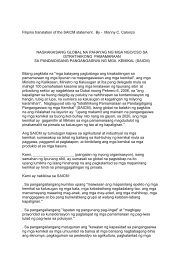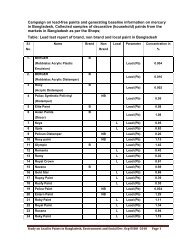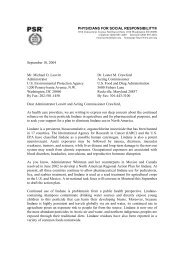The UNDP-GEF POPs Resource Kit - International POPs Elimination ...
The UNDP-GEF POPs Resource Kit - International POPs Elimination ...
The UNDP-GEF POPs Resource Kit - International POPs Elimination ...
Create successful ePaper yourself
Turn your PDF publications into a flip-book with our unique Google optimized e-Paper software.
Research on the ways <strong>POPs</strong> impact human health is continuing. More data is still<br />
needed documenting levels of <strong>POPs</strong> contamination in many countries. In addition, more<br />
health studies are needed to further explore and document the specific ways <strong>POPs</strong> harm<br />
human health under conditions in developing countries and under conditions in countries<br />
with tropical climates. Still, we already know a great deal about impacts of <strong>POPs</strong> on human<br />
health. Certainly, we know enough to justify urgent action now, to reduce and to eliminate<br />
the human exposure to these toxic chemical pollutants.<br />
Good evidence associates human exposure to specific <strong>POPs</strong> or classes of <strong>POPs</strong> with<br />
health effects, including the following:<br />
• Cancers and tumors at multiple sites;<br />
• Neurobehavioral impairment including learning disorders, reduced performance on<br />
standard tests and changes in temperament;<br />
• Immune system changes;<br />
• Reproductive deficits and sex-linked disorders;<br />
• Shortened period of lactation in nursing mothers; and<br />
• Diseases such as endometriosis (a painful, chronic gynecological disorder in which<br />
uterine tissues grow outside the uterus), increased incidence of diabetes, and others.<br />
<strong>The</strong> evidence suggests that women, infants, and children are especially vulnerable to<br />
certain effects of <strong>POPs</strong>.<br />
Mothers transfer <strong>POPs</strong> from their own body, through the placenta, into the fetus at<br />
vulnerable stages of development. This can harm the developing infant. <strong>The</strong> harm caused,<br />
however, is often not easily recognized. Learning and behavior disorders in children and<br />
adolescents have been linked to pre-natal <strong>POPs</strong> exposure. Exposure to <strong>POPs</strong> before birth also<br />
contributes to immune system disorders, to reproductive and sex-linked disorders, and to<br />
some other diseases and deficits that may only begin later in life.<br />
C. Properties of <strong>POPs</strong><br />
<strong>The</strong> Stockholm Convention identifies twelve substances as <strong>POPs</strong> under the<br />
Convention. Some are pesticides; some are industrial chemicals; some are chemical<br />
byproducts that are unintentionally formed and released to the environment in combustion<br />
and chemical processes. <strong>The</strong> twelve initial <strong>POPs</strong> or global concern are: Aldrin, Chlordane,<br />
<strong>UNDP</strong>-<strong>GEF</strong> <strong>POPs</strong> <strong>Resource</strong> <strong>Kit</strong>----------------------------------------------------------------------------------------- 7


